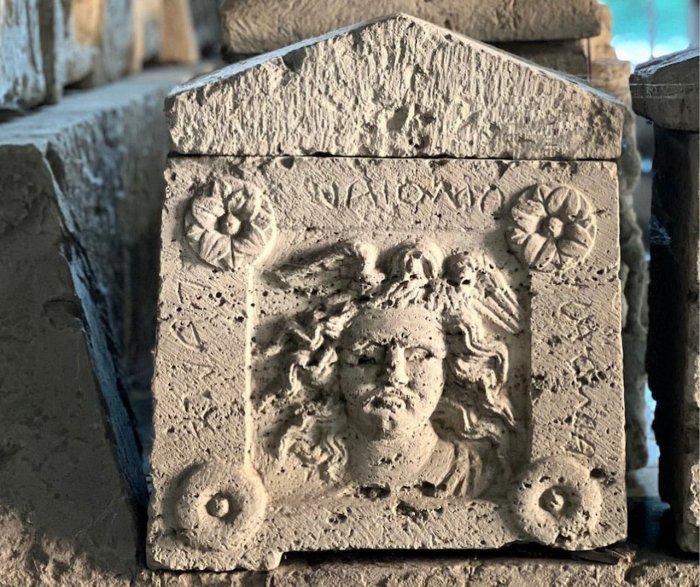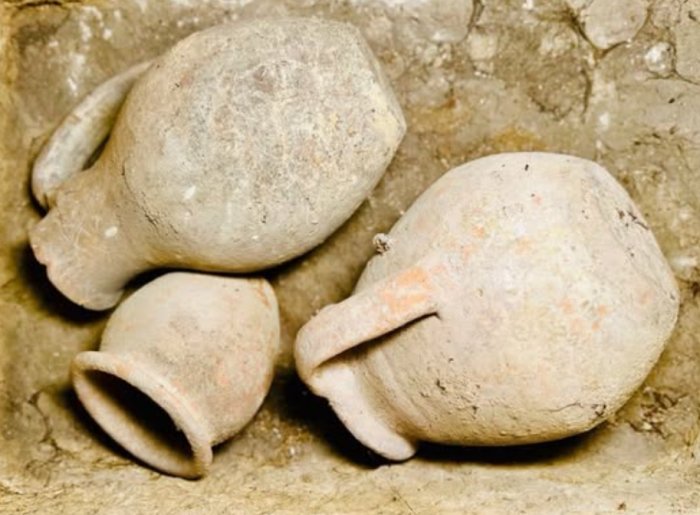Conny Waters – AncientPages.com – During routine restoration work at the necropolis of the Palazzone, located near the entrance to Perugia, archaeologists and historians made a surprising discovery.
The funeral urn with skillfully crafted Medusa relief. Image credit: Ipogeo dei Volumni e Necropoli del Palazzone
A funeral urn discovered in an underground site dating back to the 3rd century BC offers valuable insights into the ritual practices and beliefs of the Etruscans from that region. Crafted from travertine, this urn features an exceptional relief of Medusa’s head, encircled by intricate floral designs and inscriptions in Etruscan cursive. These inscriptions remain a focus of ongoing study and decipherment, promising to shed light on lesser-known aspects of Etruscan culture.
Earlier excavations at the Palazzone necropolis uncovered several tombs associated with prominent families like the Asci, highlighting the wealth and cultural sophistication of Etruscan Perugia.
However, the recent discovery of this particular urn is drawing considerable interest from the scientific community due to its intricate blend of symbolic and stylistic features.
Terracotta vessels discovered inside the travertine urn. Credit: Ipogeo dei Volumni e Necropoli del Palazzone
However, the recent discovery of this particular urn is something special, as the object has both symbolic and artistic features. The Gorgon carving surrounding floral elements and paterae, ritual disks typically found in elite burials, was carved by highly skilled artists.
The inscriptions, which were found meticulously engraved on the urn hold are of great importance. The Etruscan cursive writing, clearly visible on its surface, offers archaeologists important insights into the funeral practices of that era. The hypogeum from which this artifact originates was isolated, indicating a deliberate separation from nearby tombs. This separation might have been due to reasons related to social rank or specific cultic requirements of the family involved.
Image credit: Ipogeo dei Volumni e Necropoli del Palazzone
The inscriptions carefully carved into the travertine of the urn are of great importance. The Etruscan cursive writing, prominently displayed on its surface, provides archaeologists with valuable information about the funeral customs of that time period. The hypogeum where this artifact was found was isolated, suggesting an intentional separation from neighboring tombs.
This separation could be attributed to factors such as social status or particular religious practices associated with the family involved.
Some words of the inscriptions suggest a dedication to the patron deity of the family’s descent, while yet another suggests the significance associated with spiritual and protective elements in the Etruscan world.
When the archaeologists removed the lid, they found no bones or ashes inside. Instead, they found three terracotta vessels: a cup and two small jugs. Made of orange clay, the simple pieces were undecorated but arranged in deliberate order.
One can wonder. Was it a traditional burial, or did the object only serve as a cenotaph — a symbolic burial performed when the body was missing or buried elsewhere? The presence of the Medusa motif lends support to this theory.
The absence of human remains in the urn has led researchers to question its intended purpose.
It is suggested that the urn might serve as a cenotaph, which is a symbolic burial site created when the deceased’s body is either lost or buried elsewhere. The modest offerings found within, along with with the intricate carvings on the urn, indicate that these ritual practices were more complex than previously thought.
In Etruscan-Italic tradition, Medusa was regarded as a powerful figure used to ward off evil. Medusa depiction on the urn probably served both as protector for the serves not only as a protective symbol for its spirits. It also served as a guardian for the tomb itself.
The team plans using 3D scanning, photogrammetry, and chemical tests for detecting of ancient colors. The tomb may reveal new insights into Etruscans’ powerful families.
Written by Conny Waters – AncientPages.com Staff Writer




